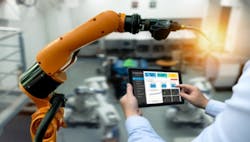Catch up, OT! Machine-learning capabilities for the operational technology side of the house
While automation and data collection have increased in the operational technology field, OT has lagged in utilizing machine learning to harness the full scope of data. Now, the divide between IT and OT environments exists for good reason—in order to keep operational technology secure there needs to be a gap between the two. However, there is tremendous room for growth in how data is utilized in OT environments, and we are just beginning to see the tip of the iceberg.
What challenges does machine learning face in OT?
Driven by the desire to increase efficiency, autonomy, and reliability, the factory floor is becoming increasingly connected. You already know this. Sensors can be found on every piece of equipment, sending a constant stream of data to be monitored and assessed. But a lot of this data is going unused or underutilized. Everyone underestimated how much IoT data there is being generated. Take for example a vibration sensor on a dynamo running at 1000 Hz; while this one piece of data is easily processed and sent to the cloud, there may be hundreds of these in a single factory, all monitoring one data point—are the dynamos vibrating normally or abnormally?
With thousands of pieces of data being collected to monitor the health of complex systems, uploading and processing this data in the cloud takes time, and business-relevant data is not available in real time. When this data is processed off-site in the cloud, organizations lose the ability to make real-time decisions based on the data being collected.
This creates a need for on-site data processing, with large-scale manufacturers turning to tools like Kafka and Kubernetes to use data in driving innovative new solutions for how to maintain and accelerate operations. This is no easy task. Legacy equipment and a lack of out-of-the-box solutions to implement these systems in an industrial environment means that finding talent that can keep pace with technology and build these systems while maintaining security is a real challenge.
Organizations are in need of methods for processing data coming from large IoT networks on site. This is where edge computing provides the platform on which machine learning and large data management can begin to make real time impacts in OT environments. By keeping data processing on site, edge networks are able to take those thousands of data points and process them in real time, only uploading the business-relevant data to the cloud. This requires another layer of compute on the factory floor.
While the amount of data collected is only going to increase, it can be harnessed in real time if it is processed locally. Machine-learning models can then provide suggestions to controllers on efficiency, safety and reliability, enabling proactive maintenance and keeping the assembly line running more consistently. Rather than replacing a controller, edge computing can augment their decisions, providing them with more refined data and greater insights into how their equipment is running.
This requires a shift in how engineers perceive this technology. There is an understandable hesitancy to adopting greater connectivity and large-scale automation for those on the factory floor. Increased connectivity comes with an increased risk of cyber-attack and professionals used to working without added levels to their IoT commonly are concerned about losing control over their systems. This is understandable.
However, the benefits of this approach have incredible potential. Data-driven innovation gained through increased monitoring and machine learning can learn faster than any human-driven approach, and as OT catches up, the sky is the limit.
Edge computing can also help to close the knowledge gap related to establishing effective computing solutions in OT environments. More and more options are becoming available for edge systems that can be installed—easily—by people working on the factory floor without bringing in more expensive consultants. By simplifying the implementation of edge computing in these environments, organizations can upgrade OT environments and employ machine-learning options without the hurdle of hiring incredibly specialized and hard-to-find IT/OT specialists.
There is great potential for applying machine learning in industrial settings. While IT has benefitted for years from centralized data and big-data processing, OT is still playing catch up. The hinderances to OT development in this area are based in practical concerns of how to process so much data in real time while maintaining cybersecurity and preventing disruptions to operations.
By utilizing edge computing in concert with cloud systems and existing knowledge from controllers and engineers, organizations can begin to apply machine learning models and increase efficiency, reliability and autonomy.
By Jeffery Ricker, co-founder and CEO of Hivecell
